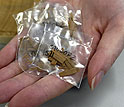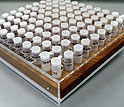News Release 05-099
Trace Gold Reveals Tree's Past

A sample has been removed from this tree slice to examine it for traces of gold.
June 14, 2005
This material is available primarily for archival purposes. Telephone numbers or other contact information may be out of date; please see current contact information at media contacts.
Using a new method to detect trace elements in tree rings, researchers at Cornell University and Penn State noticed elevated amounts of gold in specific rings and correlated several of the bands to a number of volcanic eruptions over the past 500 years.
Penn State nuclear engineer Kenan Unlu, Cornell tree-ring expert Peter Kuniholm and their colleagues believe they can use the technique not only to confirm known eruptions and other phenomena, but also to detect those events when other climatic and geologic records are missing.
Full details are available in a Penn State press release: http://live.psu.edu/story/12203
-NSF-
-
Ring samples are analyzed by neutron activation.
Credit and Larger Version -
Vials filled with samples are ready for analysis.
Credit and Larger Version
NSF Award: SBR-9905389 The Prehistory of the Eastern Mediterranean: Dendochronological, Radiocarbon and Dendrochemical Approaches
Media Contacts
Joshua A. Chamot, NSF, (703) 292-8070, email: jchamot@nsf.gov
A'ndrea Elyse Messer, Pennsylvania State University, (814) 865-9481, email: aem1@psu.edu
Program Contacts
John E. Yellen, NSF, (703) 292-8759, email: jyellen@nsf.gov
Principal Investigators
Peter Ian Kuniholm, Cornell University, (607) 255-8650, email: pik3@cornell.edu
Co-Investigators
Kenan Unlu, Pennsylvania State University, (814) 865-6351, email: k-unlu@psu.edu
The U.S. National Science Foundation propels the nation forward by advancing fundamental research in all fields of science and engineering. NSF supports research and people by providing facilities, instruments and funding to support their ingenuity and sustain the U.S. as a global leader in research and innovation. With a fiscal year 2023 budget of $9.5 billion, NSF funds reach all 50 states through grants to nearly 2,000 colleges, universities and institutions. Each year, NSF receives more than 40,000 competitive proposals and makes about 11,000 new awards. Those awards include support for cooperative research with industry, Arctic and Antarctic research and operations, and U.S. participation in international scientific efforts.
Connect with us online
NSF website: nsf.gov
NSF News: nsf.gov/news
For News Media: nsf.gov/news/newsroom
Statistics: nsf.gov/statistics/
Awards database: nsf.gov/awardsearch/
Follow us on social
Twitter: twitter.com/NSF
Facebook: facebook.com/US.NSF
Instagram: instagram.com/nsfgov




